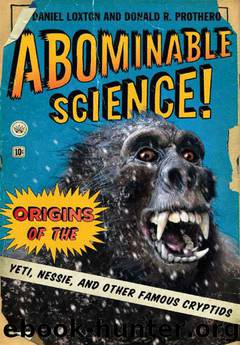Abominable Science: Origins of the Yeti, Nessie, and other Famous Cryptids by Loxton Daniel & Prothero Donald R

Author:Loxton, Daniel & Prothero, Donald R. [Loxton, Daniel]
Language: eng
Format: epub
Tags: SCI019000, Science/Paleontology, Science/Earth Sciences/General, SCI054000
Publisher: Columbia University Press
Published: 2012-08-21T04:00:00+00:00
Figure 5.23 Many nineteenth-century artists and writers depicted epic battles between the newly discovered ichthyosaurs and plesiosaurs.
Onto that stage stepped Mary Anning, a working-class Englishwoman whose sharp eye and sheer physical stamina made her (in an era of gentleman geology) perhaps the greatest fossil collector of her time. She is a romantic figure in the history of science, although she must not have considered herself in that light. I can’t help but picture her, walking along seaside cliffs near Lyme Regis, in Dorset, on damp, frigid mornings; kneeling in her long skirts; swinging her rock hammer with her calloused hands and bloodied knuckles—and all for the fossils that she would sell to survive, letting moneyed men take the credit of discovery. Yet, the large marine reptiles whose fossils she found triggered a stunning upheaval of human understanding of the past. These were creatures utterly unlike anything known. Ichthyosaurs were reptiles with shark-shaped bodies, while plesiosaurs were even weirder: long-necked reptiles that propelled themselves through the water with four paddle-like flippers. Their fossilized remains opened a window onto a lost world, paving the way for Charles Darwin—and incidentally remixing the popular legend of the sea serpent.
By nineteenth-century standards, the ink was hardly dry on newspaper reports of the sea serpent sightings around Gloucester in 1817 when ichthyosaurs were shown to be reptiles in 1821. The first nearly complete plesiosaur skeleton was described in 1824 in a presentation before the Geological Society of London—at the same meeting that announced the first dinosaur genus name: Megalosaurus.106 Almost immediately, naturalists made the connection to sea serpents. In 1827, botanist Sir William Hooker employed the newly discovered plesiosaur and dinosaur fossils as a rhetorical device, asking why it should be, when “the recent discoveries of the Plesiosaurus and Megalosaurus have made demands upon our powers of credence far greater than the serpent, the descriptions of the latter animal have received very little trust, and even much ridicule and contempt.” Hooker went on to argue that, in light of eyewitness testimony, sea serpents may now “be assumed as a sober fact in Natural History…. We cannot suppose, that the most ultra-sceptical can now continue to doubt with regard to facts attested by such highly respectable witnesses.”107
A much more direct argument was advanced in 1833 by geologist Robert Bakewell, who matter-of-factly stated in his textbook Introduction to Geology, “I am inclined to believe, that the ichthyosaurus, or some species of a similar genus, is still existing in the present seas.” Bakewell went on, “I remember one of the most particular descriptions of the sea serpent was given by an American captain …; it had paddles somewhat like a turtle, and enormous jaws like the crocodile. This description certainly approaches to, or may be said to correspond with, the ichthyosaurus, of which animal the captain had probably never heard.”108
In a footnote to Bakewell’s speculation, chemist Benjamin Silliman, a professor at Yale, made the connection that would, a century later, give form to the Loch Ness monster: “Mr. Bakewell’s
Download
This site does not store any files on its server. We only index and link to content provided by other sites. Please contact the content providers to delete copyright contents if any and email us, we'll remove relevant links or contents immediately.
Enlightenment Now: The Case for Reason, Science, Humanism, and Progress by Steven Pinker(7234)
A Journey Through Charms and Defence Against the Dark Arts (Harry Potter: A Journey Through…) by Pottermore Publishing(4781)
The Immortal Life of Henrietta Lacks by Rebecca Skloot(4525)
A Journey Through Divination and Astronomy by Publishing Pottermore(4344)
Elon Musk by Ashlee Vance(4030)
Origin Story: A Big History of Everything by David Christian(3648)
COSMOS by Carl Sagan(3554)
Alchemy and Alchemists by C. J. S. Thompson(3450)
Bad Pharma by Ben Goldacre(3356)
Enlightenment Now by Steven Pinker(3338)
Shadow of Night by Deborah Harkness(3302)
Inferior by Angela Saini(3276)
A Mind For Numbers: How to Excel at Math and Science (Even If You Flunked Algebra) by Barbara Oakley(3219)
Origin Story by David Christian(3147)
The Code Book by Simon Singh(3074)
Signature in the Cell: DNA and the Evidence for Intelligent Design by Stephen C. Meyer(3071)
The Elements by Theodore Gray(2998)
A Brief History of Time by Stephen Hawking(2961)
A Journey Through Potions and Herbology (A Journey Through…) by Pottermore Publishing(2828)
